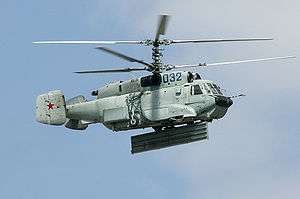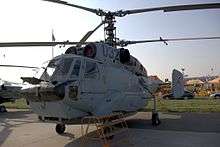Kamov Ka-31
The Kamov Ka-31 (NATO reporting name 'Helix') is a military helicopter originally developed for the Soviet Navy and currently in service in Russia, China, and India in the naval airborne early warning and control role.
| Ka-31 | |
|---|---|
 | |
| Ka-31 in 2005 | |
| Role | Airborne early warning and control |
| Manufacturer | Kamov |
| First flight | 1987 |
| Introduction | 1995 |
| Status | In service, In production |
| Primary users | Russian Navy Indian Naval Air Arm People's Liberation Army Navy |
| Produced | 1985–present |
| Number built | >35 |
| Unit cost |
$23 million (1999 rates) |
| Developed from | Kamov Ka-27 |
As with all Kamov helicopters except the Ka-60/-62 family, the Ka-31 has co-axially mounted contra-rotating main rotors. The airframe of the Ka-31 is based on the Kamov Ka-27. One visually distinctive feature of the Ka-31 is the large antenna of the early-warning radar, which is either rotating or folded and stowed under the fuselage. The second is the reduction of the bulky electro-optical sensory suite beneath the cockpit. The landing gear retracts in order to prevent interference with the radar.
Design and development
The Kamov Joint Stock Company (then, Kamov DB), began development of the Ka-31 medium-weight naval helicopter in 1980 and the first flight took place in 1987. This development was the direct result of the cancellation of the shipborne Antonov An-71 AWACS aircraft. The An-71 was intended to be deployed on the Soviet Navy's first true aircraft carrier, Admiral Kuznetsov (then known as Tbilisi). The An-71 was cancelled in favour of the Yakovlev Yak-44. Though Yak-44 was in development (and not yet cancelled) at that time, the Soviet Navy wanted a stop-gap measure and began investigating other viable platforms to act as AEW at sea.

The Soviet Navy selected the proven Kamov Ka-27 airframe. The Kamov Design Bureau was already in the process of developing the Ka-29. Nizhny Novgorod Radio Engineering Institute was working on a radar design to be used on the An-71; the same design was applied with changes for a rotary wing airframe. Integration was complete by 1980 and the helicopter was given the designation Ka-29RLD. The radar development took time and it was not until 1987 the first flight took place.[1] The production version of the Ka-29RLD/-31 was very different from the Ka-29 from which it was derived.[2]
Some of the distinct features of the Kamov Ka-31 are:[3]
- The removal of the bulky electro-optical sensor suite, beneath the cockpit.
- The cockpit is wider than the KA-27/29, with 2 additional MFDs.
- The ASW capability is not installed.
- The addition of Kronstadt Kabris 12-channel global positioning system.
- The powerplant is a more powerful Klimov TV3-117VMAR x 2. (the Ka-27 uses TV3-117BK)
- The TA-8Ka APU is added to provide power for the radar and C4ISR
- 16-channel digital communication gear with range up to 250 miles (400 km).
The radar of the Ka-31 airborne early warning helicopter has a 360° coverage and can spot aircraft-size target from 150 km range. Surface ships are spotted from 100–200 km range. Radar can track 30–40 targets simultaneously. The helicopter has a datalink to transfer target tracking data to the command post (land base or mother ship). The Ka-31 is fitted with GPS and digital terrain mapping systems.[4]
Modification
Some of the engineering changes from Ka-29 are the change in powerplant, the addition of the APUs and most importantly the secondary hydraulic system. The radar is the E-801M OKO ("EYE") planar array radar designed by the Nizhny Novgorod Radio Engineering Institute.
The operational variants delivered also had a Flight Information Recorder designed by the St.Petersburg/Leningrad Electrotechnical Institute, fitted in the tailcone. By the time the Yak-44 was canceled, additional responsibility of Command & control fell into the KA-29RLD/Ka-31's hands.
Operational history
The development and trials began in 1987 in earnest, but they were plagued by the political turmoil and the defense budget cuts in the late 1980s and the early 1990s. Finally, the aircraft entered service in very limited numbers with the Russian Navy in 1995 with its Admiral Kuznetsov-class aircraft carrier and Sovremenny-class destroyers.
The Indian Navy ordered four Ka-31 radars in 1999, and a further five in 2001. Full-scale volume production of the helicopter started in 2002. The first batch of four entered service with the Indian Navy in April 2003. The second batch were delivered in 2005.
During the period when with the retirement of an old carrier, the Indian Navy was operating a single carrier, it not only operated the helicopters from aircraft carriers and destroyers, but also from its shore-based naval air stations. The operation with the Indian Navy revealed a major drawback of the aircraft, its limited endurance/range, the chief element of a taskforce/battlegroup. In response, HAL was commissioned to experiment and possibly adapt a helicopter-to-helicopter refuelling system. Also, in the Indian service, the aircraft received Abris GPS system featuring a 12-channel receiver and option to employ Differential GPS references, designed by the Kronstad itself.[5]
The later batches featured navigational equipment for digital terrain maps, ground-proximity warning, obstacle approach warning, auto-navigation of pre-programmed routes, flight stabilization and auto homing onto and landing at the parent carrier/base and information concerning the helicopter's tactical situation.
In February 2013, official Chinese naval publications revealed that the PLA had decided to adopt the Ka-31 helicopter. It has since been reported that Chinese Ka-31s are based at naval bases in eastern China. Training is being conducted to ensure these helicopters will be able to provide service when the first Chinese aircraft carrier enters service.[6]
Operators
Specifications (Ka-31)
Data from Soviet/Russian AWACS aircraft : Tu-126, A-50, An-71 and Ka-31[9]AWACS and Hawkeyes : the complete history of airborne early warning aircraft[10]
General characteristics
- Crew: 2
- Length: 12.5 m (41 ft 0 in) rotors folded
- 11.25 m (37 ft) fuselage only
- Height: 5.6 m (18 ft 4 in)
- Gross weight: 12,500 kg (27,558 lb)
- Powerplant: 2 × Isotov TV3-117VMA turboshaft engines, 1,864 kW (2,500 hp) each take-off / contingency rating
- Main rotor diameter: 2× 15.9 m (52 ft 2 in)
- Main rotor area: 397.2 m2 (4,275 sq ft)
Performance
- Maximum speed: 250 km/h (160 mph, 130 kn)
- Cruise speed: 205 km/h (127 mph, 111 kn)
- Range: 600 km (370 mi, 320 nmi) max. fuel with radar antenna stowed
- Endurance: 2 hours 30 minutes on-station loiter at 3,500 m (11,483 ft)
See also
Related development
Aircraft of comparable role, configuration and era
- AgustaWestland AW101 Merlin ASaC5
- Westland WS-61 Sea King ASaC7
- Changhe Z-8AEW
- Changhe Z-18J
- Eurocopter AS532 Cougar Horizon
- E-2 Hawkeye
Related lists
References
- Paul Jackson (1999), Jane's All the World's Aircraft, 1999–2000, p. 372
- "Archived copy". Archived from the original on 2002-01-06. Retrieved 2008-08-22.CS1 maint: archived copy as title (link)
- http://www.airforce-technology.com/projects/ka31/%5B%5D
- http://www.military-today.com/helicopters/kamov_ka31.htm Archived 2017-07-31 at the Wayback Machine Kamov Ka-31 Helix data military-today
- "Archived copy". Archived from the original on 2008-09-17. Retrieved 2008-08-22.CS1 maint: archived copy as title (link)
- "Ka-31 in Chinese PLA Navy". Archived from the original on 2013-05-20. Retrieved 2013-06-12.
- "WORLD AIR FORCES 2011/12" (PDF). Flightglobal Insight. 2013. Archived (PDF) from the original on 9 May 2013. Retrieved 1 March 2013.
- "World Air Forces 2000 Pg. 85". flightglobal.com. Archived from the original on 3 July 2015. Retrieved 1 March 2013.
- gordon, Yefim; Komissarov, Dmitriy (2005). Soviet/Russian AWACS aircraft : Tu-126, A-50, An-71 and Ka-31. Hinkley: Midland. ISBN 9781857802153.
- Armistead, Edwin (17 March 2002). AWACS and Hawkeyes : the complete history of airborne early warning aircraft (1st ed.). MBI Pub. Co / Zenith press. p. 126. ISBN 0760311404.
External links
| Wikimedia Commons has media related to Kamov Ka-31. |